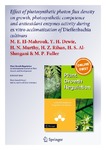Effect of photosynthetic photon flux density on growth, photosynthetic competence and antioxidant enzymes activity during ex vitro acclimatization of Dieffenbachia cultivars
| dc.contributor.author | El-Mahrouk, ME | |
| dc.contributor.author | Dewir, YH | |
| dc.contributor.author | Murthy, HN | |
| dc.contributor.author | Rihan, Hail | |
| dc.contributor.author | Al-Shmgani, HS | |
| dc.contributor.author | Fuller, MP | |
| dc.date.accessioned | 2018-01-09T20:50:40Z | |
| dc.date.available | 2018-01-09T20:50:40Z | |
| dc.date.issued | 2016-05 | |
| dc.identifier.issn | 0167-6903 | |
| dc.identifier.issn | 1573-5087 | |
| dc.identifier.uri | http://hdl.handle.net/10026.1/10529 | |
| dc.description.abstract |
The effects of 35, 70 and 100 µmol m−2 s−1 photosynthetic photon flux density (PPFD) were investigated on ex vitro acclimatization of micropropagated Dieffenbachia plants. Various growth characteristics, photosynthetic parameters and activities of antioxidant enzymes and dehydrins (DHN) were investigated. Fresh and dry plant biomass, plant height and root length were highest under the highest PPFD (100 µmol m−2 s−1), but this treatment was responsible for a reduction in the number of leaves. Chlorophyll and carotenoid contents and net photosynthesis were also optimal in plants grown under the highest irradiance. Stomatal resistance, transpiration rate and Fv/Fm values decreased with the incremental light irradiance. Activities of the antioxidant enzymes superoxide dismutase, catalase and glutathione peroxidase were higher in the plants treated with 70 and 100 µmol m−2 s−1 PPFD. Accumulation of 55 kDa, 40 and 22 kDa DHN was observed in all light treatments. These results depict that lower PPFD (35 µmol m−2 s−1) was suitable for acclimatization of Dieffenbachia plants. High PPFD (>70 µmol m−2 s−1) induced accumulation of antioxidants and accumulation of DHN in the plants which reveals enhanced stress levels. | |
| dc.format.extent | 29-37 | |
| dc.language | en | |
| dc.language.iso | en | |
| dc.publisher | Springer Science and Business Media LLC | |
| dc.subject | Acclimatization | |
| dc.subject | Antioxidants | |
| dc.subject | Dieffenbachia | |
| dc.subject | Dehydrins | |
| dc.subject | Irradiance | |
| dc.title | Effect of photosynthetic photon flux density on growth, photosynthetic competence and antioxidant enzymes activity during ex vitro acclimatization of Dieffenbachia cultivars | |
| dc.type | journal-article | |
| dc.type | Journal Article | |
| plymouth.author-url | https://www.webofscience.com/api/gateway?GWVersion=2&SrcApp=PARTNER_APP&SrcAuth=LinksAMR&KeyUT=WOS:000374270000003&DestLinkType=FullRecord&DestApp=ALL_WOS&UsrCustomerID=11bb513d99f797142bcfeffcc58ea008 | |
| plymouth.issue | 1 | |
| plymouth.volume | 79 | |
| plymouth.publication-status | Published | |
| plymouth.journal | Plant Growth Regulation | |
| dc.identifier.doi | 10.1007/s10725-015-0106-2 | |
| plymouth.organisational-group | /Plymouth | |
| plymouth.organisational-group | /Plymouth/Faculty of Science and Engineering | |
| plymouth.organisational-group | /Plymouth/Faculty of Science and Engineering/School of Biological and Marine Sciences | |
| plymouth.organisational-group | /Plymouth/REF 2021 Researchers by UoA | |
| plymouth.organisational-group | /Plymouth/REF 2021 Researchers by UoA/UoA06 Agriculture, Veterinary and Food Science | |
| plymouth.organisational-group | /Plymouth/Users by role | |
| plymouth.organisational-group | /Plymouth/Users by role/Academics | |
| dc.identifier.eissn | 1573-5087 | |
| dc.rights.embargoperiod | Not known | |
| rioxxterms.versionofrecord | 10.1007/s10725-015-0106-2 | |
| rioxxterms.licenseref.uri | http://www.rioxx.net/licenses/all-rights-reserved | |
| rioxxterms.type | Journal Article/Review |


